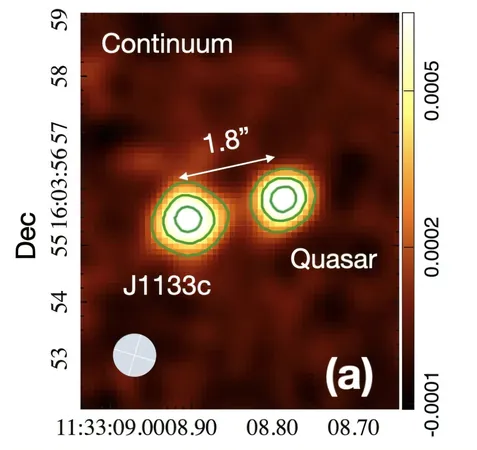
Groundbreaking Discovery: Astronomers Unveil Rare Star-Forming Galaxy Linked to Quasar!
2024-11-18
Author: Noah
Introduction
Astronomers from the Steward Observatory in Arizona have made an astonishing discovery that could shed light on the complexities of our universe. A recent paper, published on November 11, reveals the identification of a remarkable cosmic structure comprising a quasi-stellar object (QSO) and a dusty star-forming galaxy (DSFG), united by a bridge of ionized carbon. This intriguing find has sparked excitement in the scientific community, as it provides a rare glimpse into the dynamic interactions occurring during the peak epochs of cosmic history.
Understanding Quasars
Quasars, also known as QSOs, are extraordinarily luminous active galactic nuclei powered by supermassive black holes (SMBHs). They emit a wide range of electromagnetic radiation, making them some of the brightest and most distant objects observable in the universe. Astronomers rely on quasars as essential tools for various studies in astrophysics and cosmology, enabling them to explore the origins and evolution of galaxies.
Role of Mergers in Quasar Activity
Previous research has indicated that mergers play a critical role in the activation of quasars and star formation. Notably, studies suggest that nearly half of high-redshift quasars are associated with significant merging events, often involving interactions with dusty star-forming galaxies. However, finding such systems has proven to be a rarity, making this discovery of a quasar-DSFG system particularly valuable for understanding the co-evolution of galaxies and quasars during the reionization epoch.
The Discovery Process
The remarkable discovery emerged from the diligent observations conducted by astronomers led by Yongda Zhu at the Steward Observatory. Utilizing the powerful capabilities of the Atacama Large Millimeter/submillimeter Array (ALMA), the research team scrutinized 21 quasars. Their innovative analyses of ionized carbon emissions (specifically the [C II] 158µm emission line) pinpointed one quasar, designated J1133+1603, as being intricately linked to a compact, dusty star-forming galaxy identified as J1133c.
Findings from ALMA Observations
According to the researchers, the ALMA data unveiled a distinct bridge of ionized carbon connecting the quasar to the DSFG, elucidating an active ongoing interaction between the two entities, which are located approximately 32,600 light-years apart—an unusually close separation in cosmological standards.
Significance of the Discovery
The significance of this discovery lies in the implications of the C II bridge connecting J1133+1603 and J1133c, hinting at a robust merger process actively unfolding. The researchers observed extended emissions north of the quasar, further cementing the notion of dynamic interplay between these cosmic giants.
Luminosity and Star Formation Rate
Moreover, the emission analysis revealed that J1133c boasts an astounding luminosity of 14.3 tredecillion erg/s, nearly five times that of the quasar itself. This highlights intense star formation or potent activity associated with an active galactic nucleus, as the C II emission line is known to be one of the brightest indicators of star formation within galaxies.
Compact Structure of J1133c
Interestingly, J1133c displays a compact structure in both its dust continuum and C II emissions, with a star formation rate estimated to be around 1,000 solar masses per year. Such vigorous star formation rates paired with possible AGN activity in J1133c signal that it could be undergoing an extraordinary transformational phase due to the ongoing merger process.
Future Implications
As this newfound quasar-DSFG system unfolds within the vast expanses of the universe, it stands as a testament to the dynamic and often violent nature of cosmic evolution. Researchers and astronomers are eagerly anticipating further studies to gain a deeper understanding of such rare occurrences and their implications for the growth and evolution of galaxies across the universe. Stay tuned for more breathtaking revelations from the frontiers of astrophysics!









 Brasil (PT)
Brasil (PT)
 Canada (EN)
Canada (EN)
 Chile (ES)
Chile (ES)
 España (ES)
España (ES)
 France (FR)
France (FR)
 Hong Kong (EN)
Hong Kong (EN)
 Italia (IT)
Italia (IT)
 日本 (JA)
日本 (JA)
 Magyarország (HU)
Magyarország (HU)
 Norge (NO)
Norge (NO)
 Polska (PL)
Polska (PL)
 Schweiz (DE)
Schweiz (DE)
 Singapore (EN)
Singapore (EN)
 Sverige (SV)
Sverige (SV)
 Suomi (FI)
Suomi (FI)
 Türkiye (TR)
Türkiye (TR)